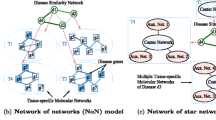Abstract
Random walk methods have been successfully applied to prioritizing disease causal genes. In this paper, we propose a bi-random walk algorithm (BiRW) based on a regularization framework for graph matching to globally prioritize disease genes for all phenotypes simultaneously. While previous methods perform random walk either on the protein-protein interaction network or the complete phenome-genome heterogenous network, BiRW performs random walk on the Kronecker product graph between the protein-protein interaction network and the phenotype similarity network. Three variations of BiRW that perform balanced or unbalanced bi-directional random walks are analyzed and compared with other random walk methods. Experiments on analyzing the disease phenotype-gene associations in Online Mendelian Inheritance in Man (OMIM) demonstrate that BiRW effectively improved disease gene prioritization over existing methods by ranking more known associations in the top 100 out of nearly 10,000 candidate genes.
Access this chapter
Tax calculation will be finalised at checkout
Purchases are for personal use only
Preview
Unable to display preview. Download preview PDF.
Similar content being viewed by others
References
Consortium The Wellcome Trust Case Control. Genome-wide association study of 14,000 cases of seven common diseases and 3,000 shared controls. Nature 447, 661–678 (2007)
Johnson, A., O’Donnell, C.: An open access database of genome-wide association resutls. BMC Med. Gent. 10, 6 (2009)
Franke, L., Bakel, H., Fokkens, L., et al.: Reconstruction of a functional human gene network, with an application for prioritizing positional candidate genes. Am. J. Hum. Genet. 78, 1011–1025 (2006)
Köhler, S., Bauer, S., Horn, D., et al.: Walking the Interactome for Prioritization of Candidate Disease Genes. Am. J. Hum. Genet. 82, 949–958 (2008)
Wu, X.B., Jiang, R., Zhang, M.Q., et al.: Network-based global inference of human disease genes. Mol. Syst. Biol. 4 (2008)
Linghu, B., Snitkin, E.S., Hu, Z., et al.: Genome-wide prioritization of disease genes and identification of disease-disease associations from an integrated human functional linkage network. Genome Biol. 10, R91 (2009)
Hwang, T.H., Kuang, R.: A Heterogeneous Label Propagation Algorithm for Disease Gene Discovery. In: Proc. of SIAM Intl. Conf. on Data Mining, pp. 583–594 (2010)
Vanunu, O., Magger, O., Ruppin, E., et al.: Associating genes and protein complexes with disease via network propagation. PLoS Comput. Biol. 6, e1000641 (2010)
Li, Y., Patra, J.C.: Genome-wide inferring gene-phenotype relationship by walking on the heterogeneous network. Bioinformatics 26, 1219–1224 (2010)
van Driel, M.A., Bruggeman, J., Vriend, G., et al.: A text-mining analysis of the human phenome. Eur. J. Hum. Genet. 14, 535–542 (2006)
McKusick, V.A.: Mendelian inheritance in man and its online version, OMIM. Am. J. Hum. Genet. 80, 588–604 (2007)
Peri, S., Navarro, J.D., Amanchy, R., et al.: Development of human protein reference database as an initial platform for approaching systems biology in humans. Genome Res. 13, 2363–2371 (2003)
Chuang, H., Lee, E., Liu, Y., et al.: Network-based classification of breast cancer metastasis. Mol. Syst. Biol. 3, 140 (2007)
Singh, R., Xu, J., Berger, B.: Pairwise Global Alignment of Protein Interaction Networks by Matching Neighborhood Topology. Res. in Comp. Mol. Biol. 4453, 16–31 (2007)
Li, Z., Zhang, S., Wang, Y., et al.: Alignment of molecular networks by integer quadratic programming. Bioinformatics 23, 1631–1639 (2007)
Guo, X., Hartemink, A.J.: Domain-oriented edge-based alignment of protein interaction networks. Bioinformatics 25, i240–i246 (2009)
Zaslavskiy, M., Bach, F., Vert, J.P.: Global alignment of protein-protein interaction networks by graph matching methods. Bioinformatics 25, i259–i267 (2009)
Singh, R., Xu, J., Berger, B.: Global alignment of multiple protein interaction networks with application to functional orthology detection. Proc. Natl. Acad. Sci. U.S.A. 105, 12763–12768 (2008)
Zhou, D., et al.: Learning with Local and Global Consistency. Advanced Neural Information Processing Systems 16, 321–328 (2004)
Chua, H., Sung, W., Wong, L.: Exploiting indirect neighbours and topological weight to predict protein function from protein-protein interactions. Bioinformatics 22, 1623–1630 (2006)
Xu, J., Li, Y.: Discovering disease-genes by topological features in human protein-protein interaction network. Bioinformatics 22, 2800–2805 (2006)
Author information
Authors and Affiliations
Editor information
Editors and Affiliations
Rights and permissions
Copyright information
© 2012 Springer-Verlag Berlin Heidelberg
About this paper
Cite this paper
Xie, M., Hwang, T., Kuang, R. (2012). Prioritizing Disease Genes by Bi-Random Walk. In: Tan, PN., Chawla, S., Ho, C.K., Bailey, J. (eds) Advances in Knowledge Discovery and Data Mining. PAKDD 2012. Lecture Notes in Computer Science(), vol 7302. Springer, Berlin, Heidelberg. https://doi.org/10.1007/978-3-642-30220-6_25
Download citation
DOI: https://doi.org/10.1007/978-3-642-30220-6_25
Publisher Name: Springer, Berlin, Heidelberg
Print ISBN: 978-3-642-30219-0
Online ISBN: 978-3-642-30220-6
eBook Packages: Computer ScienceComputer Science (R0)




